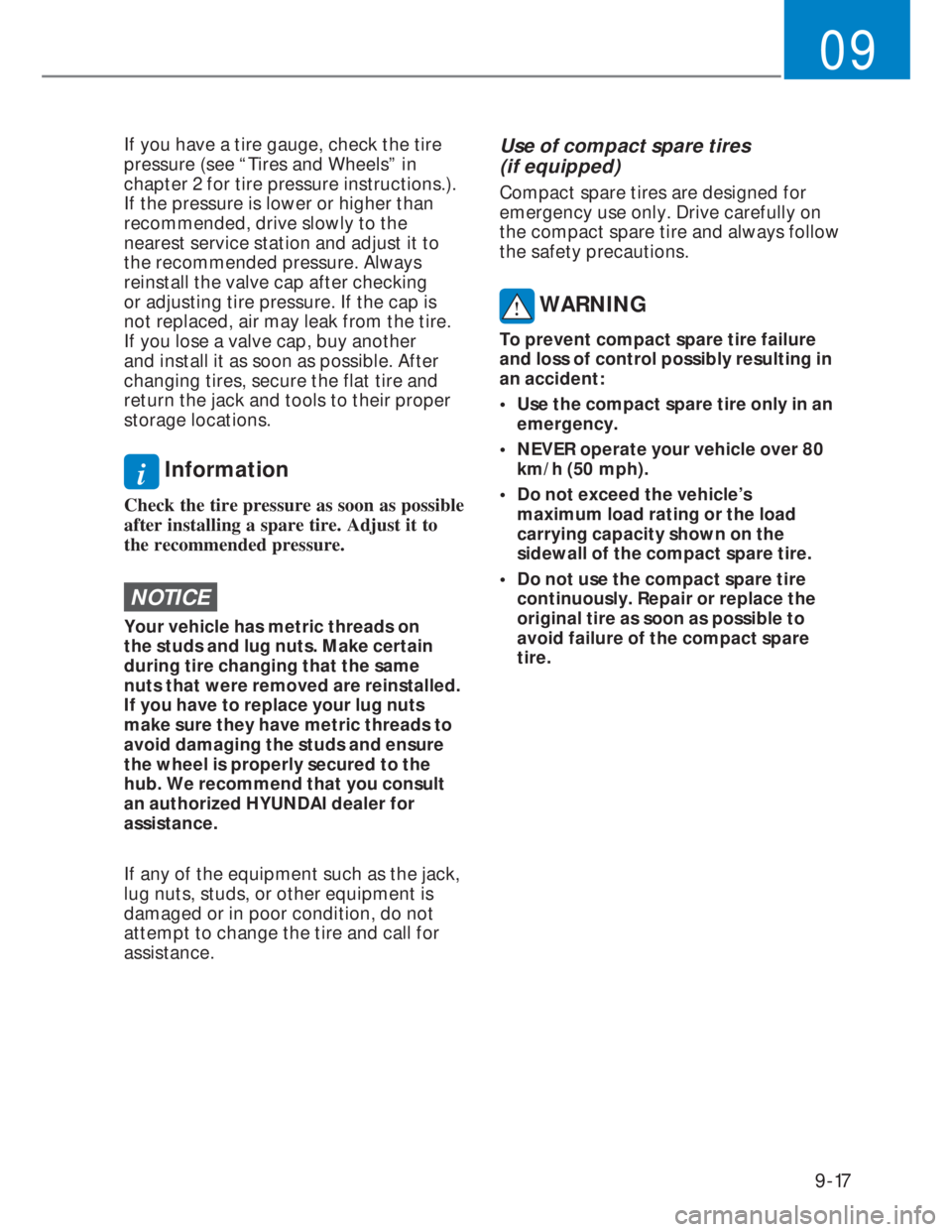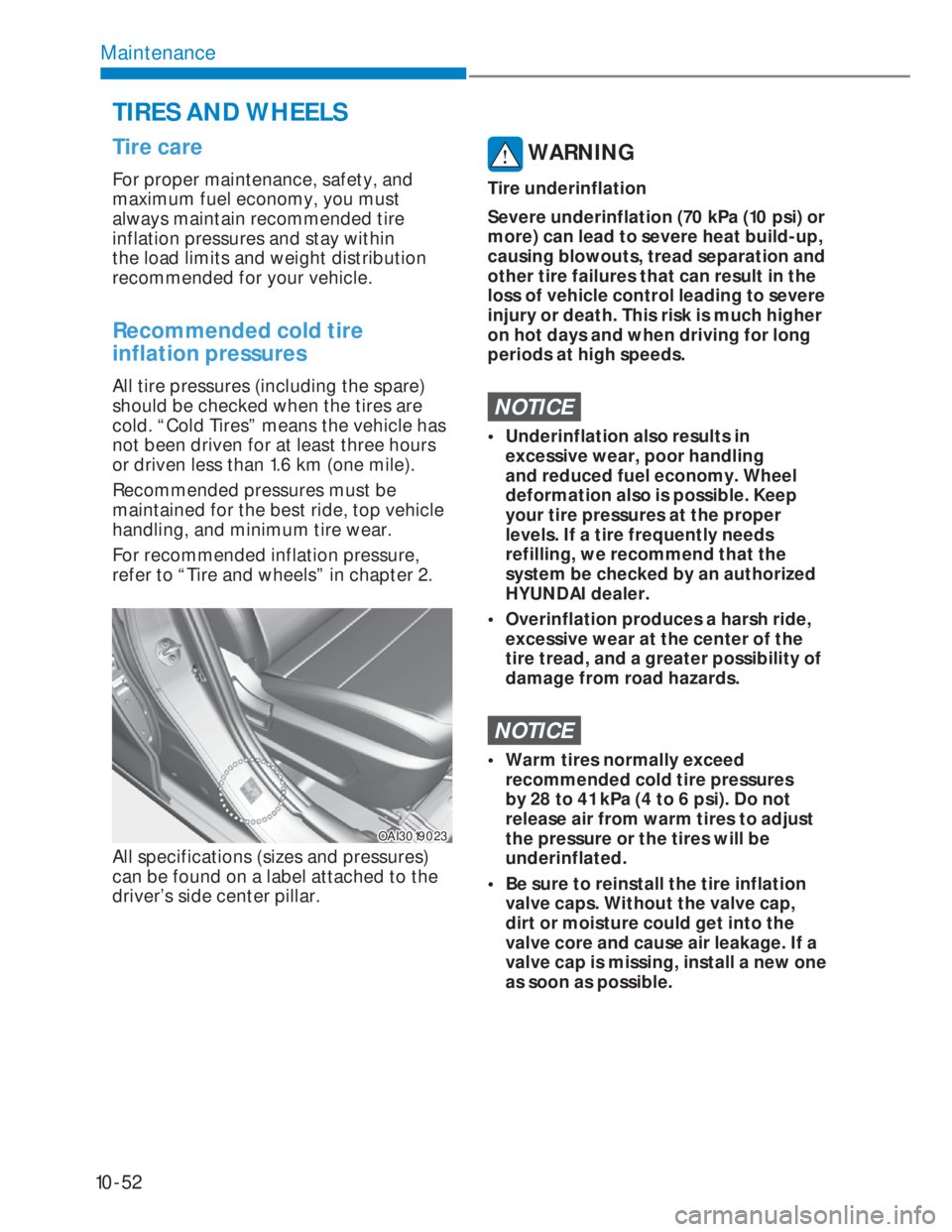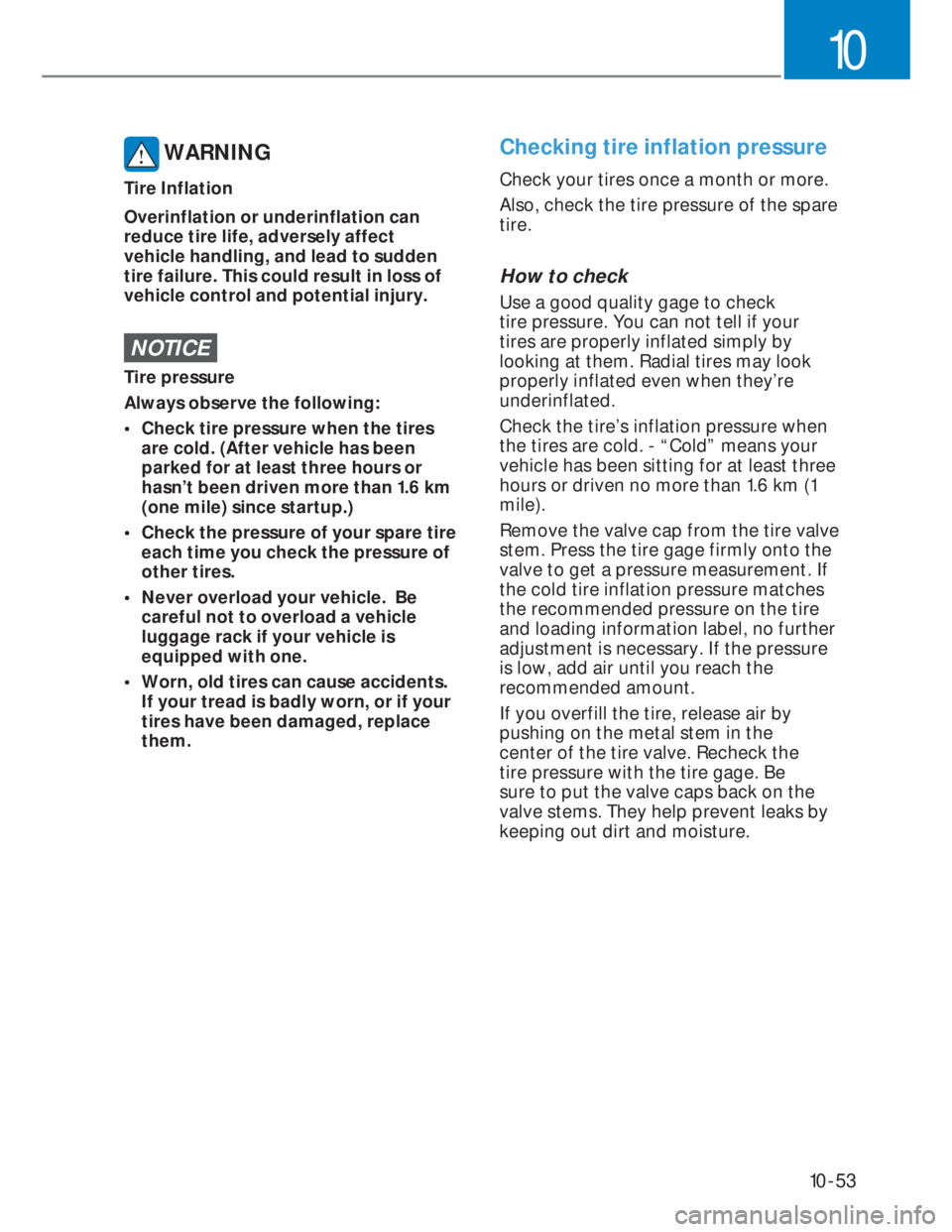2022 HYUNDAI I20 tire pressure
[x] Cancel search: tire pressurePage 327 of 444

9-13
09
NOTICE
If original mounted tire is replaced
with the spare tire, the TPMS sensor
on the replaced spare wheel should be
initiated and we recommend that the
TPMS sensor on the original mounted
wheel be deactivated by a HYUNDAI
dealer. If the TPMS sensor on the
original mounted wheel located in the
spare tire carrier still activates, the
tire pressure monitoring system may
not operate properly. We recommend
that the system be serviced by an
authorized HYUNDAI dealer.
You may not be able to identify a low
tire by simply looking at it. Always use
a good quality tire pressure gauge to
measure the tire’s inflation pressure.
Please note that a tire that is hot (from
being driven) will have a higher pressure
measurement than a tire that is cold.
A cold tire means the vehicle is in parked
position for at least 3 hours or driven
less than 1.6 km (1 mile) in that period.
Allow the tire to cool before measuring
the inflation pressure. Always be sure
the tire is cold before inflating to the
recommended pressure.
NOTICE
We recommend that you use the tire
sealant approved by HYUNDAI if your
vehicle is equipped with a Tire Pressure
Monitoring System. The liquid sealant
can damage the tire pressure sensors.
WARNING
TPMS
• The TPMS cannot alert you to severe
and sudden tire damage caused by
external factors such as nails or road
debris.
• If you feel any vehicle instability,
immediately take your foot off
the accelerator, apply the brakes
gradually and with light force, and
slowly move to a safe position off the
road.
WARNING
Protecting TPMS
Tampering with, modifying, or disabling
the Tire Pressure Monitoring System
(TPMS) components may interfere with
the system’s ability to warn the driver
of low tire pressure conditions and/
or TPMS malfunctions. Tamper-ing
with, modifying, or disabling the Tire
Pressure Monitoring System (TPMS)
components may void the war-ranty for
that portion of the vehicle.
Page 331 of 444

9-17
09
If you have a tire gauge, check the tire
pressure (see “Tires and Wheels” in
chapter 2 for tire pressure instructions.).
If the pressure is lower or higher than
recommended, drive slowly to the
nearest service station and adjust it to
the recommended pressure. Always
reinstall the valve cap after checking
or adjusting tire pressure. If the cap is
not replaced, air may leak from the tire.
If you lose a valve cap, buy another
and install it as soon as possible. After
changing tires, secure the flat tire and
return the jack and tools to their proper
storage locations.
i Information
Check the tire pressure as soon as possible
after installing a spare tire. Adjust it to
the recommended pressure.
NOTICE
Your vehicle has metric threads on
the studs and lug nuts. Make certain
during tire changing that the same
nuts that were removed are reinstalled.
If you have to replace your lug nuts
make sure they have metric threads to
avoid damaging the studs and ensure
the wheel is properly secured to the
hub. We recommend that you consult
an authorized HYUNDAI dealer for
assistance.
If any of the equipment such as the jack,
lug nuts, studs, or other equipment is
damaged or in poor condition, do not
attempt to change the tire and call for
assistance.
Use of compact spare tires
(if equipped)
Compact spare tires are designed for
emergency use only. Drive carefully on
the compact spare tire and always follow
the safety precautions.
WARNING
To prevent compact spare tire failure
and loss of control possibly resulting in
an accident:
• Use the compact spare tire only in an
emergency.
• NEVER operate your vehicle over 80
km/h (50 mph).
• Do not exceed the vehicle’s
maximum load rating or the load
carrying capacity shown on the
sidewall of the compact spare tire.
• Do not use the compact spare tire
continuously. Repair or replace the
original tire as soon as possible to
avoid failure of the compact spare
tire.
Page 332 of 444

9-18
Emergency situations
When driving with the compact spare
tire mounted to your vehicle:
• Check the tire pressure after installing
the compact spare tire. The compact
spare tire should be inflated to 420
kPa (60 psi).
• Do not take this vehicle through an
automatic car wash while the compact
spare tire is installed.
• Do not use the compact spare tire on
any other vehicle because this tire
has been designed especially for your
vehicle.
• The compact spare tire’s tread life
is shorter than a regular tire. Inspect
your compact spare tire regularly and
replace worn compact spare tires with
the same size and design, mounted on
the same wheel.
• Do not use more than one compact
spare tire at a time.
• Do not tow a trailer while the compact
spare tire is installed.
i Information
When the original tire and wheel are
repaired and reinstalled on the vehicle,
the lug nut torque must be set correctly
to prevent wheel vibration. The correct
lug nut tightening torque is 11~13 kgf.m
(79~94 lbf.ft).
NOTICE
To prevent damaging the compact
spare tire and your vehicle:
• Drive slowly enough for the road
conditions to avoid all hazards, such
as a potholes or debris.
• Avoid driving over obstacles. The
compact spare tire diameter is
smaller than the diameter of a
conventional tire and reduces the
ground clearance approximately 25
mm (1 inch).
• Do not use tire chains on the compact
spare tire. Because of the smaller
size, a tire chain will not fit properly.
• Do not use the compact spare tire
on any other wheels, nor should
standard tires, snow tires, wheel
covers or trim rings be used with the
compact spare wheel.
Page 341 of 444

10
Wiper blades ............................................................................................... 10-45
Blade inspection .....................................................................................................10-45
Blade replacement .................................................................................................10-45
Battery ......................................................................................................... 10-48
For best battery service ........................................................................................ 10-48
Battery capacity label
........................................................................................... 10-50
Battery recharging ................................................................................................ 10-48
Reset items ............................................................................................................ 10-49
Battery replacement
............................................................................................. 10-49
Tires and wheels ......................................................................................... 10-50
Tire care ................................................................................................................. 10-50
Recommended cold tire inflation pressures ....................................................... 10-50
Checking tire inflation pressure
............................................................................ 10-51
Tire rotation
............................................................................................................10-52
Wheel alignment and tire balance ........................................................................10-53
Tire replacement ....................................................................................................10-54
Wheel replacement
................................................................................................10-55
Tire traction
............................................................................................................10-55
Tire maintenance .................................................................................................. 10-56
Tire sidewall labeling ............................................................................................. 10-56
Low aspect ratio tire.............................................................................................. 10-59
Fuses ............................................................................................................. 10-61
Instrument panel fuse replacement .....................................................................10-62
Engine compartment panel fuse replacement ................................................... 10-63
Fuse/relay panel description
................................................................................ 10-64
Light bulbs .................................................................................................... 10-75
Headlight, Position Light, Turn signal Light bulb replacement ........................... 10-76
Side repeater light replacement ........................................................................... 10-81
Rear combination light bulb replacement
........................................................... 10-81
High mounted stop light replacement ................................................................ 10-85
License plate light bulb replacement .................................................................. 10-85
Interior light bulb replacement ............................................................................ 10-86
Page 347 of 444

10-8
Maintenance
The following lists are vehicle checks
and inspections that should be
performed at the frequencies indicated
to help ensure safe, dependable
operation of your vehicle.
Any adverse conditions should be
brought to the attention of your dealer
as soon as possible.
These Owner Maintenance Checks are
generally not covered by warranties and
you may be charged for labor, parts and
lubricants used.
WARNING
Diesel Engine
Never manipulate or modify the
injection system while running the
diesel engine or within 30 seconds
after turning OFF the diesel engine. The
high-pressure pump, high-pressure
pipes, rail, and injectors are still subject
to high pressure immediately after
stopping the diesel engine.
When the fuel leakage vents out, it
may cause serious body injury. Any
people, who are implanted with the
artificial cardiac pacemaker, should
remain away from the ECU or the
wiring harness by at least 30 cm,
while running the diesel engine. The
high currents of the electronic engine
control system produce a considerable
amount of magnetic fields.
Owner maintenance schedule
When you stop for fuel:
• Check the engine oil level.
• Check the coolant level in coolant
reservoir.
• Check the windshield washer fluid
level.
• Look for low or under-inflated tires.
• Check the radiator and condenser.
Check if the front of the radiator and
condenser are clean and not blocked
with leaves, dirt or insects etc.
If any of the above parts are extremely
dirty or you are not sure of their
condition, we recommend that you
contact an authorized HYUNDAI
dealer.
WARNING
Be careful when checking your engine
coolant level when the engine is hot.
Scalding hot coolant and steam may
blow out under pressure. This could
cause burns or other serious injury.
OWNER MAINTENANCE
Page 348 of 444

10-9
10
While operating your vehicle:
• Note any changes in the sound of the
exhaust or any smell of exhaust fumes
in the vehicle.
• Check for vibrations in the steering
wheel. Notice any increased steering
effort or looseness in the steering
wheel, or change in its straight-ahead
position.
• Notice if your vehicle constantly turns
slightly or “pulls” to one side when
traveling on smooth, level road.
• When stopping, listen and check for
unusual sounds, pulling to one side,
increased brake pedal travel or “hard-
to-push” brake pedal.
• If any slipping or changes in the
operation of your transmission occurs,
check the transmission fluid level.
• Check the parking brake.
• Check for fluid leaks under your
vehicle (water dripping from the air
conditioning system during or after
use is normal).
At least monthly:
• Check the coolant level in the engine
coolant reservoir.
• Check the operation of all exterior
lights, including the stoplights, turn
signals and hazard warning flashers.
• Check the inflation pressures of all
tires including the spare for tires that
are worn, show uneven wear, or are
damaged.
• Check for loose wheel lug nuts.
At least twice a year
(i.e., every Spring and Fall):
• Check the radiator, heater and air
conditioning hoses for leaks or
damage.
• Check the windshield washer spray
and wiper operation. Clean wiper
blades with clean cloth dampened
with washer fluid.
• Check the headlight alignment.
• Check the muffler, exhaust pipes,
shields and clamps.
• Check the lap/shoulder belts for wear
and function.
At least once a year:
• Clean the body and door drain holes.
• Lubricate the door hinges and checks,
and hood hinges.
• Lubricate the door and hood locks and
latches.
• Lubricate the door rubber
weatherstrips.
• Check the air conditioning system.
• Inspect and lubricate Automated
manual transmission linkage and
controls.
• Clean the battery and terminals.
• Check the brake/clutch fluid level.
Page 391 of 444

10-52
Maintenance
Tire care
For proper maintenance, safety, and
maximum fuel economy, you must
always maintain recommended tire
inflation pressures and stay within
the load limits and weight distribution
recommended for your vehicle.
Recommended cold tire
inflation pressures
All tire pressures (including the spare)
should be checked when the tires are
cold. “Cold Tires” means the vehicle has
not been driven for at least three hours
or driven less than 1.6 km (one mile).
Recommended pressures must be
maintained for the best ride, top vehicle
handling, and minimum tire wear.
For recommended inflation pressure,
refer to “Tire and wheels” in chapter 2.
OAI3019023OAI3019023
All specifications (sizes and pressures)
can be found on a label attached to the
driver’s side center pillar.
WARNING
Tire underinflation
Severe underinflation (70 kPa (10 psi) or
more) can lead to severe heat build-up,
causing blowouts, tread separation and
other tire failures that can result in the
loss of vehicle control leading to severe
injury or death. This risk is much higher
on hot days and when driving for long
periods at high speeds.
NOTICE
• Underinflation also results in
excessive wear, poor handling
and reduced fuel economy. Wheel
deformation also is possible. Keep
your tire pressures at the proper
levels. If a tire frequently needs
refilling, we recommend that the
system be checked by an authorized
HYUNDAI dealer.
• Overinflation produces a harsh ride,
excessive wear at the center of the
tire tread, and a greater possibility of
damage from road hazards.
NOTICE
• Warm tires normally exceed
recommended cold tire pressures
by 28 to 41 kPa (4 to 6 psi). Do not
release air from warm tires to adjust
the pressure or the tires will be
underinflated.
• Be sure to reinstall the tire inflation
valve caps. Without the valve cap,
dirt or moisture could get into the
valve core and cause air leakage. If a
valve cap is missing, install a new one
as soon as possible.
TIRES AND WHEELS
Page 392 of 444

10-53
10
WARNING
Tire Inflation
Overinflation or underinflation can
reduce tire life, adversely affect
vehicle handling, and lead to sudden
tire failure. This could result in loss of
vehicle control and potential injury.
NOTICE
Tire pressure
Always observe the following:
• Check tire pressure when the tires
are cold. (After vehicle has been
parked for at least three hours or
hasn’t been driven more than 1.6 km
(one mile) since startup.)
• Check the pressure of your spare tire
each time you check the pressure of
other tires.
• Never overload your vehicle. Be
careful not to overload a vehicle
luggage rack if your vehicle is
equipped with one.
• Worn, old tires can cause accidents.
If your tread is badly worn, or if your
tires have been damaged, replace
them.
Checking tire inflation pressure
Check your tires once a month or more.
Also, check the tire pressure of the spare
tire.
How to check
Use a good quality gage to check
tire pressure. You can not tell if your
tires are properly inflated simply by
looking at them. Radial tires may look
properly inflated even when they’re
underinflated.
Check the tire’s inflation pressure when
the tires are cold. - “Cold” means your
vehicle has been sitting for at least three
hours or driven no more than 1.6 km (1
mile).
Remove the valve cap from the tire valve
stem. Press the tire gage firmly onto the
valve to get a pressure measurement. If
the cold tire inflation pressure matches
the recommended pressure on the tire
and loading information label, no further
adjustment is necessary. If the pressure
is low, add air until you reach the
recommended amount.
If you overfill the tire, release air by
pushing on the metal stem in the
center of the tire valve. Recheck the
tire pressure with the tire gage. Be
sure to put the valve caps back on the
valve stems. They help prevent leaks by
keeping out dirt and moisture.